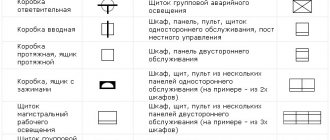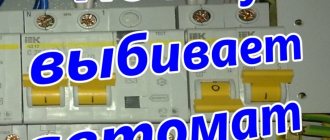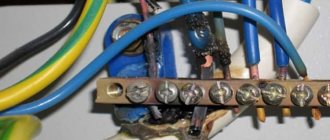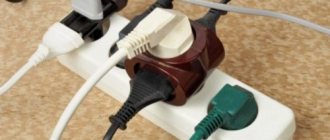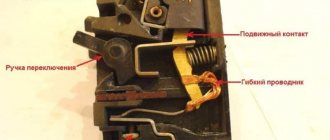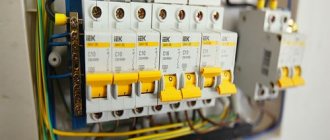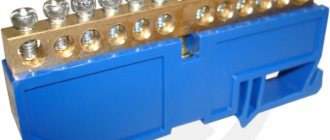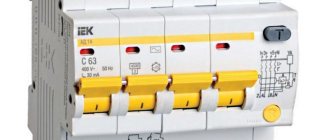Internal electrical wiring includes various elements, each of which solves its own problem. One of the most important is the incoming automatic switching device, installed in front of the meter, which allows you to automatically de-energize the line in an emergency, as well as if wiring repairs are necessary. In accordance with the requirements of the PUE, the installation of this device is mandatory, and the operation of wiring not equipped with it is not allowed. In this article we will talk about what an input circuit breaker is, how to choose this device and how input circuit breakers are calculated for a private house or apartment.
Soldering wires to the terminal of the machine - ERROR (error)
Separately, I would like to dwell on this method of terminating wires in a shield, such as soldering. Human nature is such that people try to save money on everything and do not always want to spend money on all kinds of tips, tools and all sorts of modern small things for installation.
For example, consider the case when an electrician from the housing office, Uncle Petya, wires the electrical panel with a multi-core wire (or connects outgoing lines to the apartment). He does not have NShVI tips. But you always have a good old soldering iron at hand. And the electrician, Uncle Petya, finds no other way out than to tin the multi-wire core, pushes the whole thing into the contact clamp of the machine and tightens it with a screw. Why is it dangerous to connect circuit breakers in a distribution board?
When assembling distribution boards, DO NOT solder or service the stranded core. The fact is that a tinned connection begins to “float” over time. And for such contact to be reliable, it must be constantly checked and tightened. But as practice shows, this is always forgotten. The soldering begins to overheat, the solder melts, the joint weakens even more and the contact begins to “burn out.” In general, such a connection can lead to a FIRE.
Therefore, if a stranded wire is used during installation, then NShVI lugs must be used to terminate it.
Calculation of the number of machines
How to calculate a machine for one line was discussed above. We will calculate the circuit breakers for a 1-room apartment.
The figure below shows a typical circuit for protecting the electrical wiring of a one-room apartment:
It follows from this that individual protection of lines that supply end consumers is used:
- Two AVs are installed that protect the lighting lines in the corridor and room, and the second ensures that the lighting in the toilet, bathroom and kitchen is turned off in an emergency.
- The sockets are protected not only by AB, but also by additional protection on the RCD. It protects a person from accidentally touching live parts of electrical wiring.
- The protection of sockets and washing machines is constructed in a similar way.
- There is a separate circuit breaker for the electric stove.
All devices are installed in the electrical panel. Often it is mounted in the hallway, and an electric meter and an incoming AV are installed on the site.
A 2-room apartment requires more machines. As can be seen from the diagram below.
Six automatic circuit breakers are installed in the switchboard, ensuring that lines are disconnected in the event of a short circuit or overload:
- one AB protects the lighting line of the corridor and both rooms;
- the second is installed to illuminate the kitchen, toilet and bathroom;
- the line that feeds the boiler is separately protected;
- The next circuit breaker provides protection for the sockets in the corridor, room 1, room 2, toilet and kitchen.
Thus, if a fault occurs on one of the lines, it can be easily localized and repaired.
The number of circuit breakers for a 3-room apartment or 4 rooms is calculated in a similar way. In this case, you should select an electrical panel, taking into account the number of modules in the box.
The figure above shows the installation of circuit breakers in the electrical panel of a modern apartment.
An input circuit breaker is installed in front of the circuit breakers. It protects the electrical wiring of the entire house. As a rule, the rating of the input machine is indicated in the electricity supply contract and it is impossible to change it to a higher rating without the appropriate permission (in any case, it is sealed). The input circuit breaker must be mounted before the meter, i.e. protect not only the electrical wiring of the entire house or apartment, but also the metering device.
An example is shown in the figure below:
When designing electrical wiring for a two-story house, it is suggested to install panels on each floor. At the same time, according to the PUE (chapter 1.2. clause 1.2. 11), it is recommended to install backup protective circuit breakers and provide for the possibility of developing power systems.
However, the number of backup circuit breakers or circuit breakers in the electrical panel as a whole is not regulated by any document. But when designing, it is recommended to install additional machines in the amount of 10%.
Also, if less than 10 automatic machines are installed in the panel according to the norm, then an additional backup one is installed.
How to properly connect the machine after the meter
A correctly connected VA after the meter will provide reliable protection for the wiring of an apartment or cottage. This will protect residents from electric shock and prevent the building from catching fire.
Until recently, fuses or automatic plugs were used as protection devices.
When replacing an electrical panel, protection is installed that meets the requirements of the PES. An automatic machine is installed on each line. It ensures that a specific line is switched off in an emergency.
Typical scheme
Let's look at a typical circuit diagram for connecting circuit breakers in a switchboard. For a single-phase connection to a house or apartment at 220 V, a circuit breaker is mounted on each line. This protects a separate line supplying lighting and sockets.
The cable that supplies voltage to the process equipment is protected by an RCD.
All phase conductors will be combined and connected to the VA. Do the same with neutral wires. The wires from the general circuit breaker go to the electric meter. The mains voltage is supplied to the meter through the switching device.
With three-phase voltage, the connection diagram is similar to single-phase. The difference lies in the uniform distribution of the load across the phases. And distributing it among the machines after the counter.
Sequence of work
Before installing the VA, it is necessary to carry out preparatory work. Purchase components or a standard shield.
It has already assembled a circuit and connected the machines. Before connecting, you need to turn off the power to the house. An electrician is called for this.
All that remains is to mount the input panel and connect the load. The electrician checks the correct connection of the machines to the load and the electric meter.
All that remains is to connect to the power line, apply voltage and seal the box with the VA and the electric meter.
Useful article? Rate and share with friends!
Selecting a circuit breaker by current
Why do circuit breakers need to be selected according to current? This is the main parameter that directly affects the safety of the cable line. And the circuit breaker is created only to protect the cable from its destruction.
You and I understand that if the current in the circuit exceeds that for which the cable cross-section is designed, it will heat up. The more often and more strongly this happens, the faster its insulation will collapse. We definitely don't need this.
So, the first characteristic:
#1 - Rated current
The main characteristic by which you need to choose a circuit breaker is the rated current.
What does rated current mean? At the rated current, the machine can operate indefinitely without shutting down. This is his normal operating mode.
To protect the cable at home from overload, the circuit breaker has an electromagnetic and thermal release in its design. The time and current characteristics depend on how they operate:
#2 - What do the time and current characteristics of circuit breakers mean?
The electromagnetic release is triggered when the rated current is exceeded several times and turns off the circuit almost instantly.
An electromagnetic trip unit is essentially an electromagnet that will attract the circuit breaker arm when a very large current passes through it and protect the cable from short circuiting.
What happens if the current is exceeded, but not by much?
In this case, the thermal release will operate. As the current increases, heating will occur; the more the current is exceeded, the faster the thermal release will operate.
What other parameters are important when choosing
Number of poles
For ease of understanding, we will put three-phase switches out of brackets. We choose between 1 and 2 pole designs. From the point of view of the Electrical Installation Rules (PUE), there is no difference. But the same rules imply high-quality organization of grounding or grounding. And if a problem arises with the appearance of a phase at zero (unfortunately, this is real in old housing stock), then it would be better to completely disconnect your apartment from the power lines. Therefore, if you can choose which input circuit breaker to install, take a two-pole one.
Time - current characteristic
There are different types of time-current characteristics curves, they are designated by Latin letters: A, B, C, D... Starting from A onwards, the sensitivity of the device gradually becomes rougher. For example, type “B” means operation of the electromagnetic release at 3–4 times the current, type “C” at 5–7 times, “D” at 10 times. The thermal release will operate in the same way for different types of time-current characteristics.
More accurate data should always be obtained from the manufacturer’s documentation for each specific product, for example, for BA47-29 incoming automatic machines the response characteristics are as follows:
An example of graphs for BA47-29 with characteristics (types) B, C, D is shown below in the picture; dependencies for other types can be found on the official websites of the manufacturers. The choice of one type or another is determined by the type of load being connected, or rather its ability to consume current intermittently. For example, motors have a starting current several times higher than the rated current, and depending on their types, type “C” or “D” devices can be used. Type “B” is recommended for loads that do not have significant inrush currents.
Also, the use of types with reduced sensitivity of operation makes sense to increase the probability of operation of lower groups of circuit breakers.
Rated current
The main characteristic on which the device is mainly selected. However, as we saw in the previous section, it is also necessary to take into account the time-current characteristic, since the actual operation current depends simultaneously on both the rated current and the type of characteristic. In the previous tables, the rated current is indicated as In. Theoretically, in the absence of inrush currents, a load consuming a current equal to the rated one should not lead to operation (shutdown) of the device.
Mounting method
Today, there is no alternative. These are switches that are mounted on a DIN rail. No direct screwing to the wall or panel body. DIN mounting only. However, with the use of special accessories, other types of fastening are possible.
The device can be in a separate housing, or installed in a common panel - it doesn’t matter. The main thing is to provide free access for the owner
An important point: sealing the input machine. There are many ways to restrict access to contacts (to prevent unauthorized connections). You can install plugs on the holes for tightening the screws on the contacts. Or simply put seals on the covers covering the contact groups. The main thing is that after sealing you can easily turn on and off the power supply.
Calculation of consumer power
Each electrical network in an apartment or house can be divided into sections (rooms). Depending on what devices are planned to be used in a particular area, electrical wiring calculations are made. Typically, the electrical wiring zones for each machine are divided among themselves into each room of the apartment or house. One section of wiring for one room, the second for another, and the third for the kitchen and bathroom. In this situation, such powerful consumers as electric stoves, ovens, water heaters, and heating boilers stand apart. This technique requires a dedicated power line, so in modern homes designed for use with electric stoves, a separate circuit breaker is installed to provide power to the device.
Calculating the required current for a particular section of wiring is quite simple. To do this, use the formula I=P/U, according to which I is the current strength, P is the power (in watts) of all operating electrical appliances on this line, U is the network voltage (the standard is 220 volts). To calculate, you need to add up the power of those electrical appliances that you plan to use on the line, and then divide the resulting sum by 220. From here we get the current strength, according to which you will need to select a cable of a certain cross-section.
As an example, let’s take an area (room) and calculate for it a machine and a cable of the required cross-section. The following will work simultaneously in the room:
- vacuum cleaner (1300 W);
- electric iron (1000 W);
- air conditioning (1300 W);
- computer (300 W).
Let's add these indicators (1300+1000+1300+300 = 3900 W) and divide them by 220 (3900/220 = 17.72). It turns out that the current strength is 17.72, we select the optimal cable cross-section for this based on the table, take a copper cable with a cross-section of 2.5 mm or 4 mm square (be sure to take it with a reserve) and a circuit breaker with a rated protection current of 20 amperes.
It is worth mentioning that you should not choose a circuit breaker with an overestimated rated current, since if the electrical network is overloaded (exceeding the continuous-permissible current for a particular wire), the wiring will start to catch fire. The rating of the machine must correspond to the value of the continuous-permissible current of the conductor or be less.
Experienced electricians repeatedly say that you should not install cables with a small cross-section because they are cheap; you should choose a cable with a reserve to avoid overloading the electrical section and causing a fire in the wiring. But choosing a powerful machine gun is contraindicated!
The wiring is installed once, it is difficult to replace it, but replacing the switch in the event of a significantly increased load is much easier.
At the moment, more and more powerful electrical appliances are appearing, so it’s worth taking care in advance in case you decide to use a more powerful vacuum cleaner or add some additional device to the room.
Electrical laboratory » Questions and answers » What are the features of installing an electricity meter and an automatic shutdown device at the input?
Installation of meters and automatic shutdown devices is carried out in accordance with the requirements of the PUE. The location of their installation is determined based on the type of facility and its layout and must be agreed with the energy supply. Usually, electricians install an input machine in front of the electricity meter. The electricity meter and the input machine are installed in a plastic box, which is sealed by an energy sales inspector or other authorized person. This is done to prevent illegal connection to the electric main by bypassing the meter. Our electrical laboratory will check the correct installation of your electric meter and issue a technical report .
Link to the regulatory framework:
PUE clause 1.5.6. It is recommended to install meters for calculating the electricity supply organization with electricity consumers at the boundary between the network (according to balance sheet ownership) of the electricity supply organization and the consumer. PUE clause 1.5.13. Each installed settlement meter must have seals with the state verifier's mark on the screws securing the meter casing, and on the clamping cover - a seal from the energy supply organization. Newly installed three-phase meters must have state verification seals that are no more than 12 months old, and single-phase meters must have state verification seals that are no more than 2 years old. PUE clause 1.5.27. Meters must be located in dry rooms that are easily accessible for maintenance, in a place that is sufficiently free and not cramped for work, with a temperature in winter not lower than 0 ° C. General industrial meters are not allowed to be installed in rooms where, due to production conditions, the temperature can often exceed +40 °C, as well as in rooms with aggressive environments. It is allowed to place meters in unheated rooms and corridors of switchgears of power plants and substations, as well as in outdoor cabinets. In this case, provision should be made for their stationary insulation for the winter through insulating cabinets, hoods with heating of the air inside them with an electric lamp or heating element to ensure a positive temperature inside the hood, but not higher than +20 ° C. PUE clause 1.5.29. Meters must be installed in cabinets, chambers of complete switchgears (KRU, KRUN), on panels, switchboards, in niches, on walls with a rigid structure. It is allowed to mount meters on wooden, plastic or metal panels. The height from the floor to the meter terminal box must be in the range of 0.8 - 1.7 m. A height of less than 0.8 m is allowed, but not less than 0.4 m. PUE clause 1.5.30. In places where there is a danger of mechanical damage to meters or their contamination, or in places accessible to unauthorized persons (passages, staircases, etc.), a locked cabinet with a window at dial level should be provided for meters. Similar cabinets should also be installed to co-locate meters and current transformers when performing metering on the low voltage side (at the consumer input). PUE clause 1.5.31. Designs and sizes of cabinets, niches, panels, etc. should provide convenient access to the terminals of meters and current transformers. In addition, it must be possible to conveniently replace the meter and install it with a slope of no more than 1°. The design of its fastening must ensure the possibility of installing and removing the meter from the front side. PUE clause 1.5.32. Electrical wiring to meters must meet the requirements given in Chapter. 2.1 and 3.4. PUE clause 1.5.33. The presence of rations in the electrical wiring to the settlement meters is not allowed. PUE clause 1.5.34. The cross-sections of wires and cables connected to meters must be taken in accordance with 3.4.4 (see also 1.5.19). PUE clause 1.5.35. When installing electrical wiring to connect direct-connection meters, it is necessary to leave the ends of the wires with a length of at least 120 mm near the meters. The insulation or sheath of the neutral wire at a length of 100 mm in front of the meter must have a distinctive color. PUE clause 1.5.36. For safe installation and replacement of meters in networks with voltages up to 380 V, it must be possible to turn off the meter by switching devices or fuses installed before it at a distance of no more than 10 m. Voltage relief must be provided from all phases connected to the meter. Current transformers used to connect meters at voltages up to 380V must be installed after switching devices in the direction of power flow. PUE clause 1.5.37. Grounding (grounding) of meters and current transformers must be carried out in accordance with the requirements of Chapter. 1.7. In this case, the grounding and neutral protective conductors from meters and current transformers with voltages up to 1 kV to the nearest terminal assembly must be copper. PUE clause 7.1.24. VU, ASU, main switchboard must have protection devices on all inputs of supply lines and on all outgoing lines, PUE clause 7.1.25. Control devices must be installed at the input of supply lines to the VU, ASU, and main switchboards. On outgoing lines, control devices can be installed either on each line, or be common to several lines. A circuit breaker should be considered as a protection and control device. PUE clause 7.1.26. Control devices, regardless of their presence at the beginning of the supply line, must be installed at the inputs of the supply lines in retail premises, utilities, administrative premises, etc., as well as in consumer premises that are administratively and economically isolated. PUE clause 7.1.59. In residential buildings, one single- or three-phase billing meter (with three-phase input) should be installed for each apartment. PUE clause 7.1.61. In public buildings, estimated electricity meters must be installed on the ASU (main switchboard) at the points of balance demarcation with the energy supply organization. If there are built-in or attached transformer substations, the power of which is fully used by consumers of a given building, the calculated meters should be installed at the low-voltage terminals of power transformers on combined low-voltage switchboards, which are also the building’s ASU. ASU and metering devices for different subscribers located in the same building may be installed in one common room. By agreement with the energy supplying organization, settlement meters can be installed at one of the consumers, from which the ASU supplies other consumers located in the building. At the same time, control meters should be installed at the inputs of the supply lines in the premises of these other consumers for settlements with the main subscriber. PUE clause 7.1.63. It is recommended to place residential meters together with protection devices (circuit breakers, fuses). When installing apartment panels in the hallways of apartments, meters, as a rule, should be installed on these panels; installation of meters on floor panels is allowed. PUE clause 7.1.64. To safely replace a meter directly connected to the network, a switching device must be provided in front of each meter to remove voltage from all phases connected to the meter. Disconnecting devices for removing voltage from settlement meters located in apartments must be located outside the apartment. PUE clause 7.1.65. After the meter connected directly to the network, a protection device must be installed. If several lines equipped with protection devices extend after the meter, installation of a common protection device is not required. PUE clause 7.1.66. It is recommended to equip residential buildings with remote meter reading systems.
Automatic input calculation
Regardless of whether the machine is input or not, it is calculated by summing the currents of the lines going to the loads. To do this, the power of all connected consumers is determined. The rating is determined for the simultaneous inclusion of all electricity consumers. Based on this maximum current, the closest rating of the machine from the standard range is selected downward.
The power of the input circuit breaker depends on the rated current. With three-phase power, the power is determined by how the loads are connected.
It is also necessary to determine the number of switching devices. Only one switch is required per input, and then one for each line.
For powerful appliances such as an electric boiler, water heater, oven, it is necessary to install separate automatic devices. The panel must provide space for installing additional circuit breakers.
Calculation of an introductory machine for a household electrical network
In order to choose the right input circuit breaker based on the operating current, you will first need to take into account a number of factors that influence its specific value.
- Type of power supply at this facility (two-phase or three-phase).
- The total power of all loads connected to the line.
- The presence of unaccounted for leaks and the current state of electrical wiring (its wear and tear).
AB calculation for an apartment
The calculation of the device for a separate apartment is based on the following generally accepted rules:
- To enter such housing, only two-phase 220 Volt power lines are used.
- Calculation of current consumption is made by summing all consumers connected to sockets plus the power of light bulbs (lighters) turned on simultaneously.
- An adjustment is made to the resulting value with a margin of approximately 10 percent.
For each individual consumer or apartment, according to the standards, a strictly limited current load is allocated (no more than 40 Amperes).
Taking into account the limitations and amendments, the cut-off current of the input circuit breaker is calculated and selected. If it is necessary to change its value upward, this must be agreed with local energy services and the management company.
Calculation of a machine for a private house 380 and 220 Volts
It is possible to correctly calculate which machines to install in a private home only by taking into account the following points:
- What loads are supposed to be used in the subsidiary farm, and is there any equipment among them that requires three-phase power?
- The total number of these loads and the power consumed by each of them.
- If there is 380 Volt equipment (pumps, heating boilers, engines, etc.), a 4-pole circuit breaker is selected, and in their absence, a two-pole circuit breaker is selected.
For a three-phase network, the permissible current through the releases is calculated for each phase separately.
Selecting a specific value for the machine's rating is possible only after obtaining an exact figure for the total power connected to the line of single-phase or three-phase loads
Having decided how many amperes the machine is installed in the house, we proceed to the direct installation of this device, which is important for the power supply system.
The correct calculation and competent selection of an automatic input device is given special importance for the following reasons:
- The performance of the power supply system of a residential property (apartment or private house) depends on the correct selection of VA for current.
- There will be no constant operation of it at the slightest deviation in the connected loads.
- A machine with good characteristics and proven operation will allow you to quickly turn off an apartment or house if necessary.
VA selection
The choice of device is made according to several parameters:
- Rated current. Exceeding it will cause the machine to trip due to overload. The rated current is selected based on the cross-section of the connected wiring. The permissible maximum current is determined for it, and then the nominal current for the machine is selected, having previously reduced it by 10-15%, leading to a standard series in the direction of decrease.
- Maximum short circuit current. The machine is selected according to the PKS, which must be equal to or exceed it. If the maximum short-circuit current is 4500 A, a 4.5 kA circuit breaker is selected. The switching class is selected for lighting - B (Istart>Inom 3-5 times), for powerful loads such as a heating boiler - C (Istart>Inom 5-10 times), for a three-phase motor of a large machine tool or welding machine - D (Istart> Inom 10-12 times). Then the protection will be reliable, without false positives.
- Installed power.
- Neutral mode is a type of grounding. In most cases it is a TN system with different options (TN-C, TN-CS, TN-S),
- The magnitude of the line voltage.
- Current frequency.
- Selectivity. The ratings of the machines are selected according to the distribution of loads in the lines, for example, an input machine - 40 A, an electric stove - 32 A, other powerful loads - 25 A, lighting - 10 A, sockets - 10 A.
- Power supply diagram. The machine is selected according to the number of phases: one- or two-pole for a single-phase network, three- or four-pole for a three-phase network.
- Manufacturer. In order to increase the degree of safety, the machine is selected from well-known manufacturers and specialized stores.
The number of poles for a three-phase network is four. If there are only three-phase loads with a delta connection diagram, you can use a three-pole circuit breaker.
The switch at the input must disconnect the phases and the working zero, since in the event of a leak on one of the phases to zero, there is a possibility of electric shock.
A three-pole machine can be used for a single-phase network: phase and zero are connected to two terminals, and the third will remain free.
Selecting an input circuit breaker depending on the type of grounding:
- TN-S system: supply neutral protective and working wires are separated from the substation to the consumer (Fig. a below). To simultaneously disconnect phases and zero, two-pole or four-pole input circuit breakers are used (depending on the number of phases at the input). If they have one or three poles, the neutral is carried out separately from the machines.
- TN-C system: the supply neutral protective and working wires are combined and pass to the consumer through a common conductor (Fig. b). The machine is installed single-pole or three-pole on the phase conductors, and zero is entered through the counter to the N bus.
Schemes of common types of grounding
How to connect wires to a machine: How to properly connect machines in an electrical panel
How to connect a circuit breaker | Electrician's Notes
Hello, dear readers and guests of the Electrician's Notes website.
Almost everyone can connect a circuit breaker, but they often do it not quite correctly.
The fact is that there are constant disputes between electricians: some connect power to fixed contacts, and others to moving ones. There is no need to argue, open the PUE and read clause 3.1.6:
In almost all circuit breakers, RCDs and automatic circuit breakers, the fixed contact is located on top.
Here is an example of a single-pole circuit breaker VA47-29 C16:
Similarly, for a difavtomat AVDT 32, C16, 30 (mA):
From paragraph 3.1.6. we can conclude that the phrase “must be followed, as a rule” is most likely advisory in nature, i.e. does not prohibit. That is why many electricians neglect this point. In principle, this does not affect the operation of the machine in any way; it will still turn off in the event of a short circuit or overload - I have personally checked it several times.
Let us briefly consider the design of the modular single-pole circuit breaker BA47-29. The fact is that the surface of the fixed and movable contacts have dissimilar alloys. According to IEK factory tests, when switching alternating current, both contacts burn out evenly, so it is not critical which side you connect the power to. But when switching a direct current of significant magnitude, metal transfer from one contact to another is periodically observed, so in this case, power must be supplied only to the fixed contacts.
Personally, I am a supporter of ensuring that power is always supplied to the fixed contacts in order to bring uniformity (the same everywhere) to all circuit breaker wiring diagrams, especially in the residential sector.
At the same time, electrical safety during maintenance and operation of electrical networks will increase, personnel errors when bringing electrical equipment out for repairs will be reduced, etc.
Let's move on to practice.
Connecting single-pole and double-pole circuit breakers
As a rule, in single-phase 220 (V) networks, single-pole or double-pole circuit breakers are used. If the entrance to the apartment is made with two wires (phase L - red, zero PEN - blue), i.e. If you have a TN-C system (read about it in more detail), then the diagram will be as follows:
The supply phase is connected to terminal (1) of the input single-pole circuit breaker 40 (A), and then from terminal (2) it passes through a single-phase meter and is distributed among group circuit breakers 16 (A). The supply zero passes through the meter and is connected to the PEN zero bus.
If the entrance to the apartment is made with three wires (phase L - red, zero N - blue, ground PE - yellow-green), i.e. If you have a TN-CS or TN-S system, then the diagram will be like this:
In this case, the supply phase is connected to the input two-pole circuit breaker 40 (A) to terminal (1), and zero to terminal (3). From the output terminal (2), the phase passes through the counter, the input RCD 50 (A), 100 (mA) and is distributed among the group circuit breakers 16 (A). From the output terminal (4), the zero passes through the counter, the input RCD 50 (A), 100 (mA) and is connected to the zero bus N.
Connection diagram for three-pole and four-pole circuit breakers
To connect three-phase motors, three-pole circuit breakers are used, for example, VAMU-10.
The three-phase supply voltage (A,B,C) is connected to the fixed contacts (1,3,5), and the motor winding is connected to the moving contacts (2,4,6).
In three-phase networks with a TN-C, TN-CS or TN-S grounding system, three-pole circuit breakers can also be used.
In three-phase networks with a TN-CS or TN-S grounding system, it is allowed to install four-pole circuit breakers. They are connected in the same way, only there is another “N” pole added.
Connecting wires and cables to the machine
Each machine has its own requirements for connecting conductors: cross-section, length of insulation to be stripped, type of connection. Read your passport - everything is written there.
For example, to connect a VA47-29 C10 machine, you need to strip the wire core by about 0.7-1 (cm).
Then you need to insert it into the contact clamp and secure it with a screw.
After tightening, check the fixation of the wire by lightly tugging in different directions.
If you have a flexible wire, then it is better to use lugs of the appropriate cross-section.
Make sure that no wire insulation gets under the terminal clamp.
There is no need to tighten the screw too much, because... this may lead to deformation of the circuit breaker housing. When the housing is deformed, the position of the internal current-carrying parts changes, which leads to its rapid failure or increased heating.
How to connect several circuit breakers in one row?
If several machines are installed in one row in the panel, then it is advisable to connect them together not with wire jumpers, but with a special copper connecting busbar (SC) - a “comb”. It is cut to the required length and connects the phases to all machines in the row in the required sequence.
Read more about it in this article.
Source: https://esr-energy.ru/raznoe/kak-podklyuchit-k-avtomatu-provoda-kak-pravilno-podklyuchit-avtomaty-v-elektricheskom-shhite.html
Main characteristics
One of the main characteristics of the input circuit breaker is the so-called “ultimate switching resistance” (UCR), which is usually defined as the maximum breaking and closing capabilities. Each of them is represented as the largest value of current in the switched circuit, which the given device is capable of opening (closing) while simultaneously extinguishing the resulting electric arc.
Note! On the other hand, this ability refers to the maximum value of the short-circuit current at which the machine switches off several times, while remaining fully operational. This performance indicator is usually indicated on the front panel of the device body in a place convenient for its fixation.
This performance indicator is usually indicated on the front panel of the device body in a place convenient for its fixation.
In addition to current parameters, input devices are characterized by the supply voltage with which they are designed for long-term operation. A typical apartment VA is intended for switching standard 220 Volts and has no more than 2 switching groups. And in power supply circuits laid directly from a local substation or overhead line, three-phase devices designed for a voltage of 380 Volts can be installed.
When considering various designs of water machines, differing in the number of simultaneously switchable groups of contactors, the following varieties can be distinguished:
- Single-pole switching devices;
- Double-pole circuit breakers;
- Multi-pole (three- and 4-pole) switches.
Four-pole input circuit breaker
The first two positions are used for inputting single-phase voltages, and the multi-pole circuit breaker is used for switching 380 Volt power circuits (it most often provides 3 or 4 switching groups).
Additional Information. According to the requirements of the PUE, in a single-phase network for the input of three-wire lines with a separate grounding wire, it is not allowed to use several single-pole switches (this also applies to three-phase networks of 4 wires).
When choosing an input circuit breaker, you usually install at least a two-terminal network, through which, if it is necessary to repair the electrical network, you can de-energize the apartment not only in phase, but also through the neutral wire (the neutral wire can be bypassed to the meter).
In situations where only 2 wires (without a neutral) are inserted into the house, it is allowed to install a single-pole circuit breaker. In cases where a grounding conductor is artificially added to them (by arranging repeated grounding, for example), it is necessary to use a two-pole device.
Let us consider in more detail how single- and multi-pole circuit breakers approved for use are connected.
Switching circuit of the introductory machine
Connection diagram
When connecting an input machine, it is important to follow the rule that the common cable is connected to the upper terminals, and the taps must be made from the bottom. To determine the points for supplying the power cable cores, you will need to find contacts marked F1, F2, F3 and the neutral wire N
In the absence of special markings, the buses are connected to the contacts in ascending order of their number when counting from left to right along the comb. In a 4-pole device, the first three will be phase, and the next one after them will be earth. In a 2-pole analogue, the first one on the left is phase, and the next one after it is zero.
The location where any input device is included in the general power supply circuit remains unchanged. It is installed at the very input of the supply circuit up to the sealed electric meter. After it, it is allowed to install a protective shutdown device of the second stage of operation, which improves the quality of protection against electric shock. It is more convenient to install additional automatic devices and RCDs on a common DIN rail located in the distribution cabinet next to the meter.
What to do with the introductory machine
When designing electrical wiring and dividing consumers into groups, inexperienced electricians ask the following question. If it is necessary to install 4 circuit breakers for 16A sockets and 2 circuit breakers for 10A indoor and outdoor lighting in the electrical panel, the total current of these devices will be 84A, which is much higher than the rated current of the input circuit breaker, which is 40A, and sometimes even 25A.
Maybe when dividing electrical wiring into groups, it is necessary to replace the machine with a more powerful one?
It is impossible to change the input circuit breaker to a more powerful one for several reasons:
- For each apartment or private house, the electric company allocates a certain power, which is limited by the input machine. This is done in order not to overload the supply transformers and input cables, including at the entrance.
- The rated current of the protective devices must correspond to the cross-section of the wires. Replacing these devices with more powerful ones without replacing the input cable can lead to overheating of the wires and an accident.
- In many cases, the electric company installs the input machine in a separate sealed panel. Unauthorized removal of such a seal will lead to problems with the electric company and a large fine.
- When installing electric heating or an electric stove, you must obtain permission to increase power consumption. In this case, the input circuit breaker and cable are replaced.
Information! With a significant increase in power consumption, it is advisable to replace the single-phase 220V input with a three-phase 380V and connect the groups evenly to different phases.
In fact, when dividing electrical appliances into groups, there is no need to change the input circuit breaker. The rated current of circuit breakers of individual groups shows not constant, but the maximum permissible current. For example, a 16A circuit breaker is installed in a group of indoor sockets, and the total current of the TV and mobile phone chargers is less than 1A. Even high-power devices do not work all the time, but intermittently.
Problems may arise when turning on the washing machine and dishwasher at the same time, especially together with an electric oven and electric kettle.
In this case, the total current will reach 2 kW (kettle) + 2.5 kW (dishwasher) + 2.5 kW (washing machine) + 1 kW (electric oven) = 8 kW or, in a 220V network, 36A. When the boiler or air conditioner is running, this will lead to an overload of the network and tripping of the circuit breaker. Therefore, such powerful electrical appliances must be turned on one by one.
Advantages and disadvantages
Dividing consumers into groups has advantages over connecting all devices to one machine:
- reduction of cable cross-section;
- increasing the safety of home residents;
- simplifying repairs;
- in the event of an emergency shutdown of one of the groups, the rest remain in operation;
- no need to make a complete shutdown for repairs.
In addition to advantages, separation has disadvantages:
- the calculation of electrical wiring becomes more complicated;
- the dimensions and cost of the electrical panel increase.
The complication of the input panel and installation of electrical wiring when divided into groups is justified by the convenience of further operation and repair.
Similar materials on the site:
- Electrical wiring or plaster
- Which cable is better: VVG or NUM
Design and principle of operation of the introductory machine
The input circuit breaker limits the power consumed by users.
The input circuit breaker mounted in the distribution cabinet is primarily necessary to limit the user in the useful power consumed by him. If the current exceeds the value set by this device, it will turn off and completely de-energize the apartment or country house. Taking into account this purpose, it is necessary to consider the design of the input switch, as well as the principle of its operation and its location within the cabinet.
It also performs its main function - it turns off the serviced line when the current exceeds the permissible value due to an emergency overload or short circuit. But in this purpose it is used as the second stage of group protection. The first to operate is the linear device installed directly in the damaged circuit.
Like all other circuit breakers (AB), the device mounted at the entrance to the house consists of the following mandatory components and parts:
- Housings with a set of contact connectors.
- Executive modules that ensure its operation.
- Connecting bars and fastening elements in the distribution cabinet.
In any devices of this class (including devices used for input), two switching elements called releases are used as executive modules.
One of them, related to thermal action mechanisms, is designed in the form of a bimetallic plate, and the other - as an electromagnetic overcurrent relay. The first disconnecting unit is triggered when the current in the protected line exceeds its nominal value for a long time. The electromagnetic release comes into effect when a short circuit occurs in this circuit. The magnitude of the operating currents, as well as the time delays inherent in these devices, are determined by their time-current characteristics. Thus, it ensures the compatibility of two metals that are dissimilar in structure, the direct connection of which in the form of twisting, for example, is unacceptable. It is fraught with oxidation of both conductive materials and subsequent breakdown of contact. And this usually leads to heating of the joint and its gradual destruction.
The input machine is traditionally installed directly in front of the electric meter, which allows you to take into account all internal consumers, as well as register the absence of a connection to the supply line cable. The second case is when the apartment is completely de-energized and the meter is completely disconnected from the power supply.
Where is the introductory machine installed?
The input machine can be installed before or after the counter. If installed before the electricity meter, then such a machine must be sealed.
the entry machine is sealed
For this purpose, special boxes with the possibility of sealing are produced. Or you should think about purchasing special switchboard equipment, which has a special cell for the input circuit breaker with the possibility of sealing.
Switchboard
It is necessary to take into account both which input conductor is laid to the input circuit breaker, and which conductor is laid to the loads, i.e. to lighting fixtures, sockets or any equipment.
About the repair and installation of electrical panels, read the article: “Do-it-yourself installation and repair of electrical panels”
Let's say we made a repair, replaced the aluminum wiring with copper, but such a reconstruction does not give any reason to install a 40A or 50A input circuit breaker. Because the input conductor may turn out to be too outdated and, moreover, with a cross-section of 4 square meters of aluminum. Replacing a riser with outdated wiring is not always possible. Even if we wanted to increase the rating of the input machine, sometimes this is simply unacceptable, so we will have to limit ourselves to a 25A input machine so that no trouble happens.
Which introductory machines should I use?
We sorted out single-phase and three-phase power supply. Let's now take a closer look at the power of the introductory machine. To understand exactly what power the input circuit breakers need to be installed (one is placed on the phase, and the second, although not always, on zero), you need to sum up the current of the lines that will be connected to the circuit breaker.
To do this, you should sum up the power of all electrical appliances in the house that can be turned on at the same time. But, taking into account all sorts of errors and the possibility of the emergence of new electrical appliances, you need to add at least 25-30% to the obtained value (in reserve)
In addition, when choosing input circuit breakers, it is important to take into account the maximum short-circuit current. It is best if this parameter is 1000-1500 A
Selection of circuit breaker rating based on wire cross-section
Having determined the rating of the machine based on the power of the “suspended” load, you need to make sure that the electrical wiring can withstand the appropriate current. As a guide, you can use the table below, compiled for a copper wire and a single-phase circuit (Table 3):
| cross-section , sq. mm | Allowable current, A | Max. power , kW | current , A | Possible consumers |
| 1,5 | 19 | 4,2 | 16 | Lighting, alarm |
| 2,5 | 27 | 6,0 | 25 | Socket group, warm floor |
| 4 | 38 | 8,4 | 32 | Air conditioning, water heater |
| 6 | 46 | 10,1 | 40 | Electric stove, oven |
As you can see, all three indicators (power, current and wire cross-section) are interconnected, so the rating of the machine can, in principle, be selected according to any of them. At the same time, it is necessary to make sure that all parameters fit together and, if necessary, make appropriate adjustments.
In any case, remember the following:
- Installing an overly powerful circuit breaker can lead to the fact that before it operates, electrical equipment that is not protected by its own fuse will fail.
- A machine with a low number of amperes can become a source of nervous stress, cutting off power to the house or individual rooms when the electric kettle, iron or vacuum cleaner is turned on.
Why should electrical wires be divided into groups?
Previously, in apartments and private houses the total power of installed electrical appliances was 1 kW. This made it possible to carry out wiring with aluminum wire with a cross-section of 2.5 mm² and connect all electrical appliances to a panel with an electric meter and 5A plug fuses.
Now the total currents have increased to 40A, and in some cases, for example, if there is an electric stove or electric heating, the house is connected to a 3-phase 380V network instead of single-phase wiring.
However, for the safety of home residents, the rated current of the circuit breaker must match the power of the electrical appliances. Additionally, according to the PUE (Electrical Installation Rules), it is necessary to install an RCD (residual current device) or a differential circuit breaker, the operating current of which depends on the premises that are connected to this device - from 10 to 100 mA. This complicates the input panel and makes it necessary to separate consumers.
Electrical wiring is divided into groups in two ways. They can be used separately or simultaneously:
- By power. Powerful electrical installations are connected to separate circuit breakers - washing machines, dishwashers, boilers, kitchen sockets and low-power equipment - indoor and outdoor lighting and indoor sockets.
- By position. Separate cables and protective devices connect different rooms
This division of electrical wiring into groups allows you to separately disconnect different groups and rooms when performing repair work:
- when the sockets are turned off, the lighting in the room remains on;
- When repairing lighting, you can plug a portable lamp into the outlet.
In addition, in an emergency situation, only one group of protective devices is triggered. This simplifies troubleshooting, and until the accident is eliminated, some electrical appliances remain turned on.
| In modern electrical installations, it is imperative to separate lighting and power parts into groups. That is, lighting lines should not be connected to socket lines. |
Diagram for connecting an ouzo to a group of machines
Colleagues by vocation often ask me one question, which I am already tired of answering, so I decided to write about it on my blog. The nature of the question is approximately the following: “if you use one ROUZ for connection to several circuit breakers, what should the rated current of this ROUZ be? What will be the diagram for connecting an ouzo to a group of machines? How many machines can be connected to one ouzo?” In general, all these questions are from the series of correct connection of the ouzo, so let's look at them in detail.
We advise you to study the Device for measuring battery capacity
Everyone knows that the residual current device does not have its own protection against overloads and short circuits. An automatic machine must be installed in tandem with the RCD. This duo works something like this: if a current leak occurs along the line, the RCD is triggered, if overcurrents occur along the line, the machine is triggered.
Basic rules for calculating parameters
You need to decide which machines to install in your apartment and how to correctly carry out the calculations to select the appropriate model.
There are two basic rules for calculating the parameters of circuit breakers:
The rated current should slightly exceed the permissible power of a particular line at maximum load. Ensuring maximum load on the line is quite simple; you need to simultaneously turn on all household appliances, lighting and electrical appliances. If you neglect this rule, the machine will continuously turn off. To prevent overheating of the wire cores, there must be a limit on the maximum current values. Otherwise, in relation to the electrical wiring, the machine will not perform its protective function
It is worth paying attention to one common mistake when choosing a machine - “the main thing is not to have less current.” This approach will lead to the fact that the machine will not operate even at the moment when the wiring is on.
The permissible current load limits for electrical wiring in an apartment are indicated in the PUE table (for cables with copper conductors):
| Core cross-section | Current strength for laid wires | |||||
| Open | In one pipe | |||||
| One three-wire | One two-wire | Four solid | Three single core | Two single-core | ||
| 0,5 | 11 | – | – | – | – | – |
| 0,75 | 15 | – | – | – | – | – |
| 1 | 17 | 14 | 15 | 14 | 15 | 16 |
| 1,2 | 14,5 | 16 | 15 | 16 | 18 | 20 |
| 1,5 | 23 | 15 | 18 | 16 | 17 | 19 |
| 2 | 26 | 19 | 23 | 20 | 22 | 24 |
| 2,5 | 30 | 21 | 25 | 25 | 25 | 27 |
| 3 | 34 | 24 | 28 | 26 | 28 | 32 |
| 4 | 41 | 27 | 32 | 30 | 35 | 38 |
| 5 | 46 | 31 | 37 | 34 | 39 | 42 |
| 6 | 50 | 34 | 40 | 40 | 42 | 46 |
| 8 | 62 | 43 | 48 | 46 | 51 | 54 |
| 10 | 80 | 50 | 55 | 50 | 60 | 70 |
Unacceptable mistakes when purchasing
The most common mistakes when choosing and purchasing an input circuit breaker are ignorance of the principles of its operation and choosing a machine rating lower or higher than the required value. If you choose a machine with a lower rating, then it is possible that the protection will trigger falsely and shut down the entire apartment due to one device.
There are also “professionals” who connect two single-pole circuit breakers instead of a two-terminal circuit, not knowing that this violates electrical safety requirements and the PUE prohibits such a connection.
If you have doubts about the selection and installation of such a device, you should contact a professional electrician and rest assured that the correct choice and safe installation.
We advise you to study the Device for measuring battery capacity
Differences between VU (input device) and ASU (input distribution device)
In the IU (input device), unlike the ASU, there are no circuit breakers for distributing power supply to individual groups. The input device is installed either on a power line pole (as in the photo), or near the house or in the house itself. The ASU is installed only in the house.
Water devices can be with or without electricity meters. But here it is necessary to note:
Note: According to the latest regulations, the electric meter must be installed outdoors. In a sealed case with a transparent window for reading meter readings. Therefore, organizing the power supply at home according to the scheme: power line, VU (input device), electric meter, on the street, and only then a separate distribution board in the house, is quite justified.
